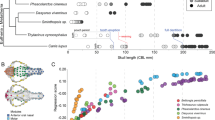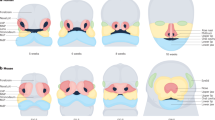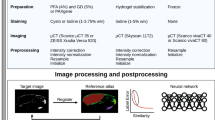Abstract
To artists, the face is a mirror of the soul. To biologists, the face reflects remarkable structural diversity — think of bulldogs and wolfhounds or galapagos finches. How do such variations in skeletal form arise? Do the same mechanisms control skeletogenesis elsewhere in the body? The answers lie in the molecular machinery that generates neural crest cells, controls their migration, and guides their differentiation to cartilage and bone.
This is a preview of subscription content, access via your institution
Access options
Subscribe to this journal
Receive 51 print issues and online access
$199.00 per year
only $3.90 per issue
Buy this article
- Purchase on Springer Link
- Instant access to full article PDF
Prices may be subject to local taxes which are calculated during checkout



Similar content being viewed by others
References
Picasso, P. Picasso on Art: A Selection of Views (ed. Dore, A.) (Thames and Hudson, London, 1972).
Garcia-Castro, M. I., Marcelle, C. & Bronner-Fraser, M. Ectodermal Wnt function as a neural crest inducer. Science 13, 13 (2002).
Aybar, M. J., Nieto, M. A. & Mayor, R. Snail precedes slug in the genetic cascade required for the specification and migration of the Xenopus neural crest. Development 130, 483–494 (2003).
Birgbauer, E., Sechrist, J., Bronner-Fraser, M. & Fraser, S. Rhombomeric origin and rostrocaudal reassortment of neural crest cells revealed by intravital microscopy. Development 121, 935–945 (1995).
Vitelli, F., Morishima, M., Taddei, I., Lindsay, E. A. & Baldini, A. Tbx1 mutation causes multiple cardiovascular defects and disrupts neural crest and cranial nerve migratory pathways. Hum. Mol. Genet. 11, 915–922 (2002).
Garg, V. et al. Tbx1, a DiGeorge syndrome candidate gene, is regulated by Sonic hedgehog during pharyngeal arch development. Dev. Biol. 235, 62–73 (2001).
Kulesa, P. M. & Fraser, S. E. In ovo time-lapse analysis of chick hindbrain neural crest cell migration shows cell interactions during migration to the branchial arches. Development 127, 1161–1172 (2000).
Kulesa, P., Bronner-Fraser, M. & Fraser, S. In ovo time-lapse analysis after dorsal neural tube ablation shows rerouting of chick hindbrain neural crest. Development 127, 2843–2852 (2000).
Holder, N. & Klein, R. Eph receptors and ephrins: effectors of morphogenesis. Development 126, 2033–2044 (1999).
Smith, A., Robinson, V., Patel, K. & Wilkinson, D. G. The EphA4 and EphB1 receptor tyrosine kinases and ephrin-B2 ligand regulate targeted migration of branchial neural crest cells. Curr. Biol. 7, 561–570 (1997).
Eickholt, B. J., Mackenzie, S. L., Graham, A., Walsh, F. S. & Doherty, P. Evidence for collapsin-1 functioning in the control of neural crest migration in both trunk and hindbrain regions. Development 126, 2181–2189 (1999).
Golding, J. P., Trainor, P., Krumlauf, R. & Gassmann, M. Defects in pathfinding by cranial neural crest cells in mice lacking the neuregulin receptor ErbB4. Nature Cell Biol. 2, 103–109 (2000).
Gassmann, M. et al. Aberrant neural and cardiac development in mice lacking the ErbB4 neuregulin receptor. Nature 378, 390–394 (1995).
Golding, J. P., Tidcombe, H., Tsoni, S. & Gassmann, M. Chondroitin sulphate-binding molecules may pattern central projections of sensory axons within the cranial mesenchyme of the developing mouse. Dev. Biol. 216, 85–97 (1999).
McGonnell, I. M. & Graham, A. Trunk neural crest has skeletogenic potential. Curr. Biol. 12, 767–771 (2002).
Nakamura, H. & Ayer-le Lievre, C. S. Mesectodermal capabilities of the trunk neural crest of birds. J. Embryol. Exp. Morphol. 70, 1–18 (1982).
Shah, N. M., Groves, A. K. & Anderson, D. J. Alternative neural crest cell fates are instructively promoted by TGFβ superfamily members. Cell 85, 331–343 (1996).
Smith, A. & Graham, A. Restricting Bmp-4 mediated apoptosis in hindbrain neural crest. Dev. Dyn. 220, 276–283 (2001).
Anderson, D. J. et al. Cell lineage determination and the control of neuronal identity in the neural crest. Cold Spring Harb. Symp. Quant. Biol. 62, 493–504 (1997).
Baroffio, A., Dupin, E. & Le Douarin, N. M. Clone-forming ability and differentiation potential of migratory neural crest cells. Proc. Natl Acad. Sci. USA 85, 5325–5329 (1988).
Groves, A. K. & Bronner-Fraser, M. Competence, specification and commitment in otic placode induction. Development 127, 3489–3499 (2000).
Gans, C. & Northcutt, R. G. Neural crest and the origin of vertebrates: a new head. Science 220, 268–274 (1983).
Jiang, X., Iseki, S., Maxson, R. E., Sucov, H. M. & Morriss-Kay, G. M. Tissue origins and interactions in the mammalian skull vault. Dev. Biol. 241, 106–116 (2002).
Noden, D. M. The control of avian cephalic neural crest cytodifferentiation. I. Skeletal and connective tissues. Dev. Biol. 67, 296–312 (1978).
Lumsden, A. G. Spatial organization of the epithelium and the role of neural crest cells in the initiation of the mammalian tooth germ. Development 103(Suppl.), 155–169 (1988).
Chai, Y. et al. Fate of the mammalian cranial neural crest during tooth and mandibular morphogenesis. Development 127, 1671–1679 (2000).
Chai, Y. & Slavkin, H. C. Prospects for tooth regeneration in the 21st century: a perspective. Microsc. Res. Tech. 60, 469–479 (2003).
Wilson, C. Cutting edge. New Sci. 175, 32 (2002).
Noden, D. M. The role of the neural crest in patterning of avian cranial skeletal, connective, and muscle tissues. Dev. Biol. 96, 144–165 (1983).
Couly, G., Grapin-Botton, A., Coltey, P., Ruhin, B. & Le Douarin, N. M. Determination of the identity of the derivatives of the cephalic neural crest: incompatibility between Hox gene expression and lower jaw development. Development 125, 3445–3459 (1998).
Trainor, P. A., Ariza-McNaughton, L. & Krumlauf, R. Role of the isthmus and FGFs in resolving the paradox of neural crest plasticity and prepatterning. Science 295, 1288–1291 (2002).
Gendron-Maguire, M., Mallo, M., Zhang, M. & Gridley, T. Hoxa-2 mutant mice exhibit homeotic transformation of skeletal elements derived from cranial neural crest. Cell 75, 1317–1331 (1993).
Rijli, F. M. et al. A homeotic transformation is generated in the rostral branchial region of the head by disruption of Hoxa-2, which acts as a selector gene. Cell 75, 1333–1349 (1993).
Creuzet, S., Couly, G., Vincent, C. & Le Douarin, N. M. Negative effect of Hox gene expression on the development of the neural crest-derived facial skeleton. Development 129, 4301–4313 (2002).
Schneider, R. A. & Helms, J. A. The cellular and molecular origins of beak morphology. Science 299, 565–568 (2003).
Hu, D., Marcucio, R. & Helms, J. A. A zone of frontonasal ectoderm regulates patterning and growth in the face. Development 130, 1749–1758 (2003).
Couly, G., Creuzet, S., Bennaceur, S., Vincent, C. & Le Douarin, N. M. Interactions between Hox-negative cephalic neural crest cells and the foregut endoderm in patterning the facial skeleton in the vertebrate head. Development 129, 1061–1073 (2002).
Kendrick, K. M., da Costa, A. P., Leigh, A. E., Hinton, M. R. & Peirce, J. W. Sheep don't forget a face. Nature 414, 165–166 (2001).
Kimmel, C. B., Miller, C. T. & Moens, C. B. Specification and morphogenesis of the zebrafish larval head skeleton. Dev. Biol. 233, 239–257 (2001).
Schilling, T. F. & Kimmel, C. B. Segment and cell type lineage restrictions during pharyngeal arch development in the zebrafish embryo. Development 120, 483–494 (1994).
Prince, V. & Lumsden, A. Hoxa-2 expression in normal and transposed rhombomeres: independent regulation in the neural tube and neural crest. Development 120, 911–923 (1994).
Trainor, P. A. & Krumlauf, R. Patterning the cranial neural crest: hindbrain segmentation and Hox gene plasticity. Nature Rev. Neurosci. 1, 116–124 (2000).
Capecchi, M. R. Hox genes and mammalian development. Cold Spring Harb. Symp. Quant. Biol. 62, 273–281 (1997).
Amores, A. et al. Zebrafish hox clusters and vertebrate genome evolution. Science 282, 1711–1714 (1998).
Popperl, H. et al. lazarus is a novel pbx gene that globally mediates hox gene function in zebrafish. Mol. Cell 6, 255–267 (2000).
Cooper, K. L., Leisenring, W. M. & Moens, C. B. Autonomous and nonautonomous functions for Hox/Pbx in branchiomotor neuron development. Dev. Biol. 253, 200–213 (2003).
Prince, V. E., Moens, C. B., Kimmel, C. B. & Ho, R. K. Zebrafish hox genes: expression in the hindbrain region of wild-type and mutants of the segmentation gene, valentino. Development 125, 393–406 (1998).
Hunter, M. P. & Prince, V. E. Zebrafish Hox paralogue group 2 genes function redundantly as selector genes to pattern the second pharyngeal arch. Dev. Biol. 247, 367–389 (2002).
Schilling, T. F. et al. Jaw and branchial arch mutants in zebrafish I: branchial arches. Development 123, 329–344 (1996).
Yanagisawa, M. et al. A novel potent vasoconstrictor peptide produced by vascular endothelial cells. Nature 332, 411–415 (1988).
Remuzzi, G., Perico, N. & Benigni, A. New therapeutics that antagonize endothelin: promises and frustrations. Nature Rev. Drug Discov. 1, 986–1001 (2002).
Miller, C. T., Schilling, T. F., Lee, K., Parker, J. & Kimmel, C. B. sucker encodes a zebrafish Endothelin-1 required for ventral pharyngeal arch development. Development 127, 3815–3828 (2000).
Ahlgren, S. C., Thakur, V. & Bronner-Fraser, M. Sonic hedgehog rescues cranial neural crest from cell death induced by ethanol exposure. Proc. Natl Acad. Sci. USA 99, 10476–10481 (2002).
Hu, D. & Helms, J. A. The role of Sonic hedgehog in normal and abnormal craniofacial morphogenesis. Development 126, 4873–4884 (1999).
Napoli, J. L. Interactions of retinoid binding proteins and enzymes in retinoid metabolism. Biochim. Biophys. Acta 1440, 139–162 (1999).
Schneider, R. A., Hu, D., Rubenstein, J. L., Maden, M. & Helms, J. A. Local retinoid signaling coordinates forebrain and facial morphogenesis by maintaining FGF8 and SHH. Development 128, 2755–2767 (2001).
Keeler, R. F. & Binns, W. Teratogenic compounds of Veratrum californicum (Durand). V. Comparison of cyclopian effects of steroidal alkaloids from the plant and structurally related compounds from other sources. Teratology 1, 5–10 (1968).
Incardona, J. P., Gaffield, W., Kapur, R. P. & Roelink, H. The teratogenic Veratrum alkaloid cyclopamine inhibits Sonic hedgehog signal transduction. Development 125, 3553–3562 (1998).
Cordero, D. R., Schneider, R. A. & Helms, J. A. in Craniofacial Surgery: Science & Surgical Technique (eds Lin, K. Y., Ogle, R. C. & Jane, J. A.) 75–83 (W. B. Saunders, Philadelphia, 2002).
Cooper, M. K., Porter, J. A., Young, K. E. & Beachy, P. A. Teratogen-mediated inhibition of target tissue response to Shh signaling. Science 280, 1603–1607 (1998).
Cordero, D. R., Marcucio, R., Gaffield, W., Tapadia, M. & Helms, J. A. Temporal disruption in Sonic Hedgehog signalling mimics the phenotypic range of holoprosencephaly. Nature Med. (submitted).
Chiang, C. et al. Cyclopia and defective axial patterning in mice lacking Sonic hedgehog gene function. Nature 383, 407–413 (1996).
Cole, F. & Krauss, R. S. Microform holoprosencephaly in mice that lack the Ig superfamily member Cdon. Curr. Biol. 13, 411–415 (2003).
Beverdam, A. et al. Jaw transformation with gain of symmetry after Dlx5/Dlx6 inactivation: mirror of the past? Genesis 34, 221–227 (2002).
Depew, M. J., Lufkin, T. & Rubenstein, J. L. Specification of jaw subdivisions by Dlx genes. Science 298, 381–385 (2002).
Cohen, M. M. Jr Craniofacial disorders caused by mutations in homeobox genes MSX1 and MSX2. J. Craniofac. Genet. Dev. Biol. 20, 19–25 (2000).
Gorlin, R. J. Fibroblast growth factors, their receptors and receptor disorders. J. Craniomaxillofac. Surg. 25, 69–79 (1997).
Levine, J. P., Bradley, J. P., Roth, D. A., McCarthy, J. G. & Longaker, M. T. Studies in cranial suture biology: regional dura mater determines overlying suture biology. Plast. Reconstr. Surg. 101, 1441–1447 (1998).
Warren, S., Brunet, L., Harland, R. M., Economides, A. & Longaker, M. T. The BMP antagonist noggin regulates cranial suture fusion. Nature 422, 625–629 (2003).
Liu, Y. H. et al. Msx2 gene dosage influences the number of proliferative osteogenic cells in growth centers of the developing murine skull: a possible mechanism for MSX2-mediated craniosynostosis in humans. Dev. Biol. 205, 260–274 (1999).
Satokata, I. et al. Msx2 deficiency in mice causes pleiotropic defects in bone growth and ectodermal organ formation. Nature Genet. 24, 391–395 (2000).
Mavrogiannis, L. A. et al. Haploinsufficiency of the human homeobox gene ALX4 causes skull ossification defects. Nature Genet. 27, 17–18 (2001).
Carter, D. C. & Giori, N. J. in The Bone-Biomaterial Interface (ed. Davis, J. E.) 367–379 (University of Toronto Press, Toronto, 1991).
Carter, D. R., Beaupré, G. S., Giori, N. J. & Helms, J. A. Mechanobiology of skeletal regeneration. Clin. Orthopaed. Rel. Res. 82, S41–S55 (1998).
Probst, A. & Spiegel, H. U. Cellular mechanisms of bone repair. J. Invest. Surg. 10, 77–86 (1997).
Colnot, C., Thompson, Z., Miclau, T., Werb, Z. & Helms, J. Altered bone regeneration in the absence of MMP9. Development (in the press).
Wagner, W. & Harrison, M. R. Fetal operations in the head and neck area: current state. Head Neck 24, 482–490 (2002).
Noden, D. M. in Factors and Mechanisms Influencing Bone Growth (eds Dixon, A. D. & Sarnat, B. G.) 168–203 (Alan R. Liss, New York, 1982).
Lee, S. H., Fu, K. K., Hui, J. N. & Richman, J. M. Noggin and retinoic acid transform the identity of avian facial prominences. Nature 414, 909–912 (2001).
Lucas, A. M. & Stettenheim, P. R. Avian Anatomy: Integument (United States Department of Agriculture, Washington DC, 1972).
Noden, D. M. Origins and patterning of craniofacial mesenchymal tissues. J. Craniofac. Genet. Dev. Biol. 2, 15–31 (1986).
Acknowledgements
We gratefully acknowledge helpful discussions with R. Marcucio, C. Kimmel, T. Schilling, M. Bronner-Fraser, D. Noden, M. Longaker, Y. Chai and R. Maxson. This work was supported by NIH grants to J.A.H. and R.A.S.
Author information
Authors and Affiliations
Corresponding author
Rights and permissions
About this article
Cite this article
Helms, J., Schneider, R. Cranial skeletal biology. Nature 423, 326–331 (2003). https://doi.org/10.1038/nature01656
Issue Date:
DOI: https://doi.org/10.1038/nature01656
This article is cited by
-
Molecular and cellular mechanisms underlying the evolution of form and function in the amniote jaw
EvoDevo (2019)
-
Cross-talk between lung cancer and bones results in neutrophils that promote tumor progression
Cancer and Metastasis Reviews (2018)
-
Evolution of beak morphology in the Ground Tit revealed by comparative transcriptomics
Frontiers in Zoology (2017)
-
Skeletal Site-specific Effects of Zoledronate on in vivo Bone Remodeling and in vitro BMSCs Osteogenic Activity
Scientific Reports (2017)
-
In Vitro Osteogenic Differentiation of Human Mesenchymal Stem Cells from Jawbone Compared with Dental Tissue
Tissue Engineering and Regenerative Medicine (2017)
Comments
By submitting a comment you agree to abide by our Terms and Community Guidelines. If you find something abusive or that does not comply with our terms or guidelines please flag it as inappropriate.



